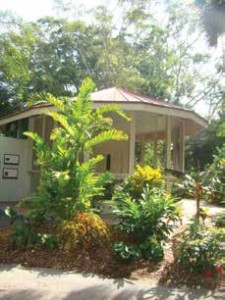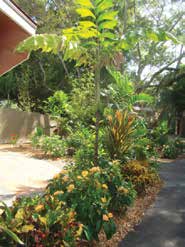Zoo Landscapes – A tail/tale of two exhibits at Naples Zoo
by Darryl Windham
Naples Zoo Grounds Supervisor
 While walking through Naples Zoo at Caribbean Gardens one can’t help but notice the lush tropical plantings that create a unique backdrop for the visitors and animal exhibits alike.
While walking through Naples Zoo at Caribbean Gardens one can’t help but notice the lush tropical plantings that create a unique backdrop for the visitors and animal exhibits alike.
Henry Nerhling’s original plantings provided the backbone that has allowed the Zoo to continue expanding those gardens to where they are today. Zoo horticulturists strive to immerse the visitors into an all-encompassing experience by selecting plants that mimic the habitat of the animal being displayed. Indeed, creating landscapes in a zoo setting differs from residential and commercial landscapes in several ways, but there is one main factor that dictates what and how we use plants for these landscapes: the animals.
Climate, appropriate plant material for the animal being displayed, plant toxicity, and potential invasiveness all must be considered when selecting plants to use in new exhibits and renovation of existing exhibits.
No matter where a zoo is located, climate is one of the main driving forces when it comes to choosing plants when creating new zoological habitats. Whether you are in Seattle, Washington or Phoenix, Arizona, you must try to create or mimic a realistic exhibit with plants that grow well in your climate.
 With the subtropical climate of Southwest Florida, horticulturists at Naples Zoo are lucky to have a large palette of plants at our disposal in which to create these new, realistic habitats. Naples Zoo recently opened two new exhibits that challenged us to use two very different parts of that palette to pull off the look that we were going for: a reticulated python and a Florida panther exhibit.
With the subtropical climate of Southwest Florida, horticulturists at Naples Zoo are lucky to have a large palette of plants at our disposal in which to create these new, realistic habitats. Naples Zoo recently opened two new exhibits that challenged us to use two very different parts of that palette to pull off the look that we were going for: a reticulated python and a Florida panther exhibit.
When the reticulated python exhibit was finished, it included messaging about the reticulated python’s smaller, more invasive cousin, the Burmese python, which has become established in South Florida. Escaped and released Burmese pythons now number in the thousands and they are breeding across southern Florida.
Although they are a very real threat to our local ecosystems, they are only a small part of a much larger problem. More than 500 species of nonnative wildlife have been found in Florida and while most will never have the opportunity to reproduce, many nonnative species of fish, frogs, lizards, birds, mammals, insects, and reptiles now call Florida home. We can all help by reporting pythons and other invasive species by calling 1-888-Ive-Got-1 or downloading the free IveGot1 app.
 To echo that messaging, the second major factor that zoo horticulturists must consider is the use of invasive or potentially invasive species and not to use those plants whenever possible.
To echo that messaging, the second major factor that zoo horticulturists must consider is the use of invasive or potentially invasive species and not to use those plants whenever possible.
So keeping in mind the use of invasive plants and the native range of the reticulated python, we set out to create the landscape surrounding the new python exhibit. With the design of the interior exhibit building being restrictive, the shape and the layout of the pathways, and how the exhibit was situated we opted not to go for a realistic habitat, but a landscape that showcased unique plant specimens found throughout the native range of the reticulated python. Some plants that were selected were Philippine Fig (Ficus pseudopalma), Highland Betel Nut Palm (Areca macrocalyx), Nasturtium Tree (Macaranga grandifolia), and Timor Black Bamboo (Bambusa lako).
 When the time came to design and install the landscape for the new Florida panther exhibit, we had to look no further than Collier County’s own backyard for inspiration and ideas. Given the fact that Naples Zoo was converting an existing big cat exhibit for panther, there was plenty of opportunity to create a realistic naturalized habitat inside the exhibit. During this conversion, zoo horticulturists must find the right balance of landscape when designing an exhibit landscape. The challenge is to plant enough plants to provide adequate cover for the animal and screening behind the scenes areas, while still giving zoo visitors a great viewing area of the animal. This is a balance that we often struggle with, but for the well being of the animal exhibited, a necessary one.
When the time came to design and install the landscape for the new Florida panther exhibit, we had to look no further than Collier County’s own backyard for inspiration and ideas. Given the fact that Naples Zoo was converting an existing big cat exhibit for panther, there was plenty of opportunity to create a realistic naturalized habitat inside the exhibit. During this conversion, zoo horticulturists must find the right balance of landscape when designing an exhibit landscape. The challenge is to plant enough plants to provide adequate cover for the animal and screening behind the scenes areas, while still giving zoo visitors a great viewing area of the animal. This is a balance that we often struggle with, but for the well being of the animal exhibited, a necessary one.
With the Florida Panther being one of the state’s flagship conservation species, we used native plant species that are found throughout Southwest Florida, the panther’s native habitat. Working alongside Florida Evergreen Landscape & Lawn Care, tree species that were chosen were Bald Cypress (Taxodium distichum), Slash Pine (Pinus elliottii), Live Oak (Quercus virginaiana), Cabbage Palm (Sabal palmetto), and Satinleaf (Chrysophyllum oliviforme). Wax Myrtle (Myrica cerifera), Cocoplum (Chrysoblanum icaco), Simpson’s Stopper (Myrcianthes fragrans), Silver Saw Palmetto (Serenoa repens), Wild Coffee (Psychotria nervosa), and Fiddlewood (Citharexylum fruticosum) were some of the shrubs used, as well as Fakahatchee Grass (Tripsicum dactyloides).
In the end, after the exhibit opens with the animal’s needs having been met and the visitor has a unique educational and entertaining time while at the zoo, the zoo horticulturist can truly call this a success.
Sometimes the animals enjoy the landscaping in their exhibits a little too much, (often as a snack or back rub) but as long as the animal’s well being has been enriched, it goes with the territory. So the next time you visit Naples Zoo at Caribbean Gardens, stop by these new exhibits and think about how the plants enhance the exhibit and the experience. In this unique industry we have a saying about Zoo Horticulture: It’s all around you!

Leave a Reply
Want to join the discussion?Feel free to contribute!